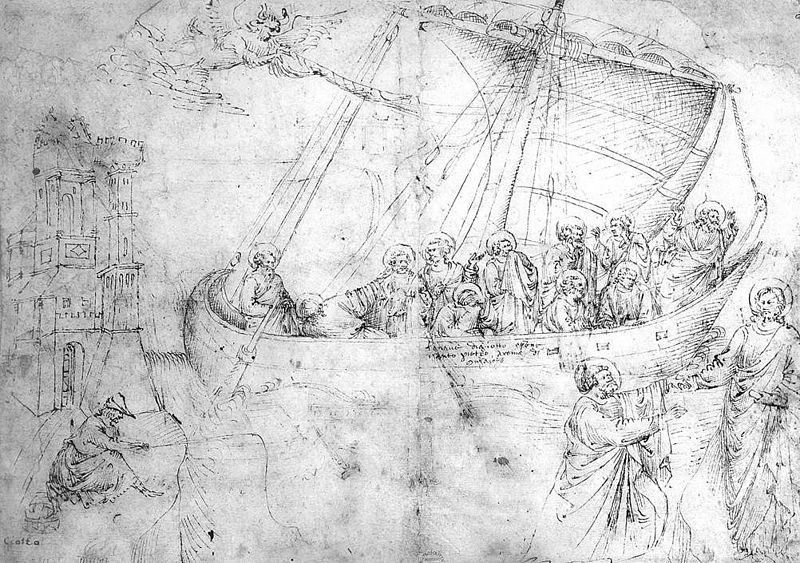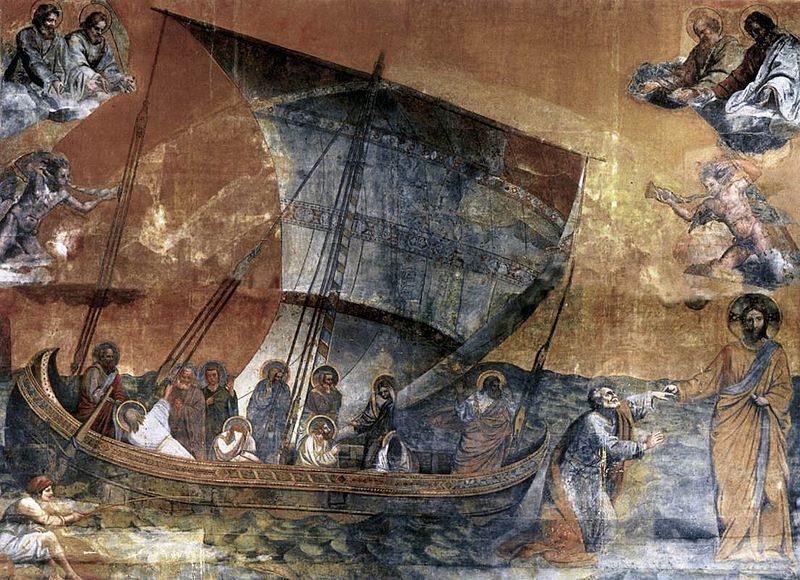Lazio : Navicella
Around 1305-1313, Giotto de Bondone created a gigantic mosaic on the wall above the entrance façade of Old Saint Peter’s Basilica in Rome. It depicted Christ Walking on the Water from the Gospel of Matthew where Saint Peter is summoned to join him. Unfortunately, it was destroyed during the construction of the new Saint Peter’s Basilica in the 17th century, but fragments have been preserved for us to judge the style of the work and some of Giotto’s drawings have also been left behind. The mosaic was designed to be seen from a distance, positioned so that the people leaving the basilica saw it across the courtyard outside the church and passed under it if they left by the main route. The design of this mosaic is similar to the type of design seen in the frescoes of the Arena Chapel, which was also painted by Giotto and commissioned by Enrico Scrovegni. During the time of the plague, Scrovegni’s intention was to be able to go to heaven when he died by taking his family fortunes and create an entire narrative of the Life of Christ for people to look up to. Just like Scrovegni's need for indulgence in salvation for their sins, millions of Pilgrims traveled to Rome to see the Navicella and many other sites in order to avoid Purgatory and be happy in the afterlife.
The Gospel of Matthew 14:24-33:
But the boat was now in the midst of the sea, distressed by the waves; for the wind was contrary. And in the fourth watch of the night he came unto them, walking upon the sea. And when the disciples saw him walking on the sea, they were troubled, saying, It is a ghost; and they cried out for fear. But straightway Jesus spake unto them, saying Be of good cheer; it is I; be not afraid. And Peter answered him and said, Lord, if it be thou, bid me come unto thee upon the waters. And he said, Come. And Peter went down from the boat, and walked upon the waters to come to Jesus. But when he saw the wind, he was afraid; and beginning to sink, he cried out, saying, Lord, save me. And Immediately Jesus stretched forth his hand, and took hold of him, and saith unto him, O thou of little faith, wherefore didst thou doubt? And when they were gone up into the boat, the wind ceased. And they that were in the boat worshipped him, saying, Of a truth thou art the Son of God.
The mosaic was large in scale as the waves swell up above the heads of the disciples on the right and seemingly above the spectator. The mast and billowing sail seem vast in proportion to the disciples and tilt dangerously as one disciple is pulling on the ropes with all his might to prevent it from overturning. Jesus, is the only subject appearing on the waves to remain vertical, while the other disciples are expressed, withdrawn, panicking, or out of their minds clinging to the side of the boat. One of the eleven figures holding the tiller, which provides leverage, is suggested to be Saint Paul. In the sky, there are two classical style nude “wind god” figures one each side of the mosaic. Overall, the composition was dominated by the fishing boat with its large sail, but this represented a metaphor for the “Ship of the Church”, where St. Peter is the captain and his successors as Pope. Although Peter did not immediately recognize Jesus in the midst of the storm, he was still saved from sinking after he realized that the Lord was the only one who could have helped him. The Navicella was created in the 14th century in order to “assure visitors to the basilica that, what ever the vicissitudes of the moment, the church was in the good hands of Christ” (I), giving “magniloquent” and “hyperbolic” images to signify the rhetoric and power that cast its spell on the basilica. The mosaic was commissioned by Cardinal Jacopo Stefaneschi, during a very difficult time for the Papacy. Although unable to control the gangsterish nobility of Rome, and therefore left the city, the Navicella promised that the church and Papacy were “unsinkable” with the help of Christ. Leon Battista Alberti, an Italian architect, humanist, painter, and art critic, included a description of Giotto’s Navicella in De Pictura as representing the “eleven disciples struck with far and wonder at the sight of their colleague walking on water, each showing such clear signs of his agitation in his face and entire body that their individual emotions are discernible in every on of them “ (158, Storytelling in Christian Art from Giotto to Donatello, Lubbock).


